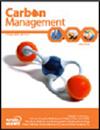土地利用变化对土壤和生物质固碳的影响:来自加纳奥瓦比水库集水区的案例研究
IF 3.2
4区 环境科学与生态学
Q3 ENVIRONMENTAL SCIENCES
引用次数: 0
摘要
本文章由计算机程序翻译,如有差异,请以英文原文为准。
Implications of changes in land use on soil and biomass carbon sequestration: a case study from the Owabi reservoir catchment in Ghana
Abstract Land use changes affect soil and biomass carbon sequestration potential of the agroecosystems of most Sub-Sahara Africa facing rising temperatures due to global climate change. One such ecosystem is the Owabi reservoir catchment in Ghana, which has undergone extensive changes in land use through urbanization. Our study aimed to determine the impact of the spatial and temporal variability of the different land uses on soil and biomass carbon storage in the Owabi catchment. Land use/cover maps were elaborated using SPOT satellite images of 30 × 30-m resolution and Erdas Imagine and ArcGIS Pro softwares. Soil and vegetation were sampled along three transects in the Y plane in early 2014. Nested plot design and temporary sample plots of 50 × 50 m were demarcated within a 1 ha plot in each of the land uses. Trees, herbs and litter were sampled to assess aboveground carbon, and soil samples were taken at 0–15 cm and 15–30 cm depth. Belowground (root) biomass was calculated using the root:shoot ratio. Seven (7) land use types – dense forest, sparse forest, grassland, cropland, wetland, settlement, and excavated land – were identified and differences in carbon stocks were assessed. Soil carbon stock (0–30 cm) ranged from 51.80 Mg/ha in dense forest to 7.00 Mg/ha in excavated land. Our study showed that the conversion of forest lands to other land uses through excavation resulted in about 30-folds loss in carbon and also a major loss of carbon in the catchment from c. 1.4 × 106 Mg C in 1990 to 0.55 × 106 Mg C in 2014. Enhancing forests or growing trees to sequester carbon seems to be the optimum choice among the seven land uses if the introduction of payment for environmental services options is considered.
求助全文
通过发布文献求助,成功后即可免费获取论文全文。
去求助
来源期刊

Carbon Management
ENVIRONMENTAL SCIENCES-
CiteScore
5.80
自引率
3.20%
发文量
35
期刊介绍:
Carbon Management is a scholarly peer-reviewed forum for insights from the diverse array of disciplines that enhance our understanding of carbon dioxide and other GHG interactions – from biology, ecology, chemistry and engineering to law, policy, economics and sociology.
The core aim of Carbon Management is it to examine the options and mechanisms for mitigating the causes and impacts of climate change, which includes mechanisms for reducing emissions and enhancing the removal of GHGs from the atmosphere, as well as metrics used to measure performance of options and mechanisms resulting from international treaties, domestic policies, local regulations, environmental markets, technologies, industrial efforts and consumer choices.
One key aim of the journal is to catalyse intellectual debate in an inclusive and scientific manner on the practical work of policy implementation related to the long-term effort of managing our global GHG emissions and impacts. Decisions made in the near future will have profound impacts on the global climate and biosphere. Carbon Management delivers research findings in an accessible format to inform decisions in the fields of research, education, management and environmental policy.
 求助内容:
求助内容: 应助结果提醒方式:
应助结果提醒方式:


